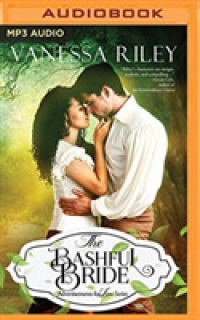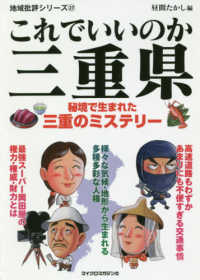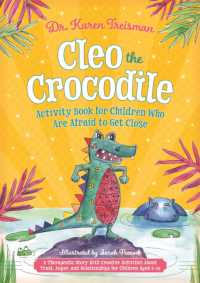- ホーム
- > 洋書
- > 英文書
- > History / World
Full Description
Written in a lively and accessible style, Feast of Excess traces in brief chapters the history of the New Sensibility in America. The book opens with John Cage in 1952, experimenting with an excess of minimalism in his musical piece of silence, 4' 33" and in his chaotic, maximalist work Theater Piece, No. 1. Feast concludes in 1974 with performance artist Chris Burden who, among other things, had himself shot in the arm, crucified to a VW bug, and spent days scrunched up in a locker. Each chapter, devoted to a single year, allows for the moment of creation to be fixed in the biography of the artist(s), the historical moment, and the emerging tradition of the New Sensibility. This New Sensibility was predicated upon excess, pushing things, going too far, whether in the direction of minimalism or maximalism. This excess was, in general, directed at shared concerns, including violence, madness, sexuality, confession, the performative, breaking down barriers between artist and audience, and between high and low culture. It was about liberation. The New Sensibility emerged across varied artistic endeavors in the early 1950s before being named as a specific phenomenon in the mid-1960s by both Susan Sontag and Tom Wolfe. By the middle 1970s, this excess in American culture had become established as the norm. It remains the essence of our culture today, for good and ill. The excess at the center of the New Sensibility can disgust, at times, but when it is leavened with a sense of limits, it can result in cultural products of the highest quality, as well as resist easy consumption and commodification.
Contents
Introduction: The New Sensibility ; Prelude: A New Year: Judith Malina ; Emergence, 1952-1960 ; Ch. 1 - - 1952: Sounds of Silence: John Cage ; Ch. 2 - - 1953: Erasure and Addition: Robert Rauschenberg ; Ch. 3 - - 1954: The Wild One: Marlon Brando ; Ch. 4 - - 1955: Ever Mysterious: Patricia Highsmith ; Ch. 5 - - 1956: Howling in the Wilderness: Allen Ginsberg ; Ch. 6 - - 1957: 'Great Balls of Fire': Jerry Lee Lewis ; Ch. 7 - - 1958: To 'Nullify Explanation': Robert Frank ; Ch. 8 - - 1959: Making a Connection: Judith Malina and Jack Gelber ; Ch. 9 - - 1960: All About Me: Norman Mailer ; Explosion, 1961-1969 ; Ch.10 - -1961: Say What? : Lenny Bruce ; Ch.11- - 1962: Pop Goes the Paradigm ; Ch.12- - 1963: Picking His Nose at Tradition: Andy Warhol ; Ch.13- - 1964: Naming the New: Susan Sontag ; Ch.14- - 1965: 'How Does It Feel?': John Coltrane and Bob Dylan ; Ch.15- - 1966: Living and Dying: Anne Sexton ; Ch.16- - 1967: 'Utmost Freedom of Imagination': William Styron ; Ch.17- - 1968: An 'Extreme Gesture': Gore Vidal ; Cultural Commonplace, 1970-1974 ; Ch.18- - 1969: 'Terribleness': Amiri Baraka ; Ch.19- - 1970: 'I Just Love Freaks': Diane Arbus ; Ch.20- - 1971: Vegas, Baby!: Robert Venturi, Denise Scott Brown, Hunter Thompson ; Ch.21- - 1972: Erectile Destruction: Samuel R. Delany and Thomas Pynchon ; Ch.22- - 1973: Zipless Abandon: Erica Jong ; Ch.23- - 1974: Crucified and Shot: Chris Burden ; Conclusion: The Shock of the Old - and New ; Index







